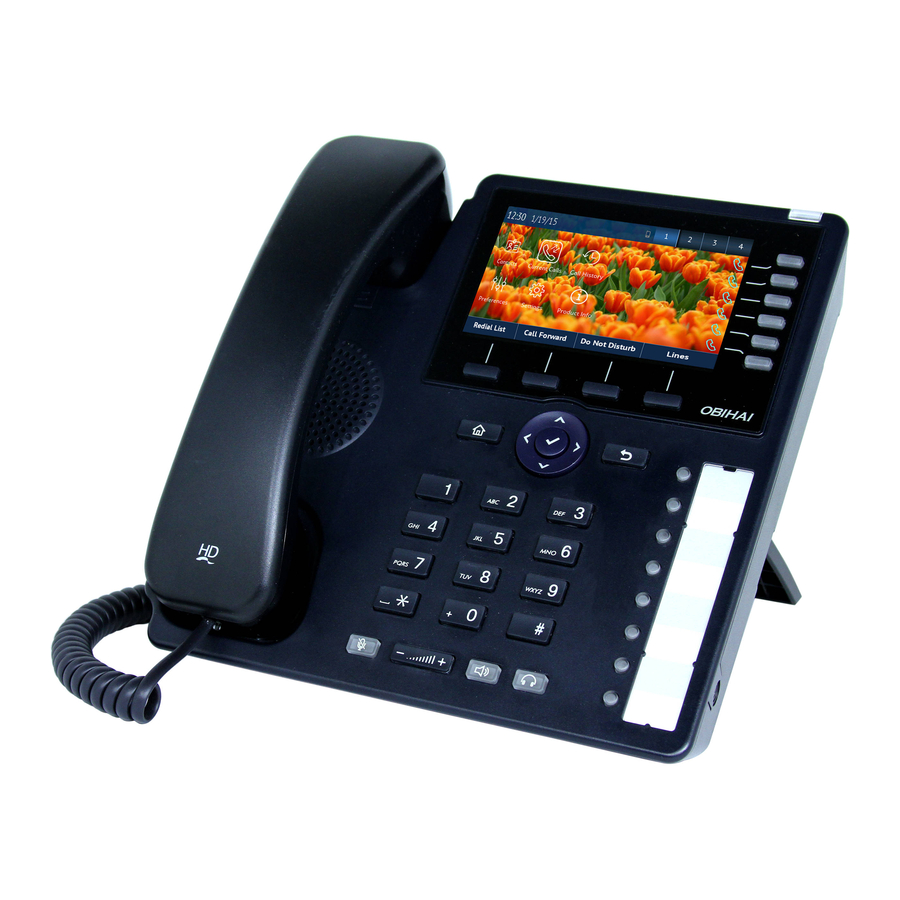
Obihai OBi1032 Configuration Manual
Hide thumbs
Also See for OBi1032:
- Administration manual (220 pages) ,
- User manual (84 pages) ,
- User manual (62 pages)
Summary of Contents for Obihai OBi1032
-
Page 1: Table Of Contents
Home PBXware SERVERware TELCOware SIPmon SIPProt Desktop & Mobile UADs Appliances From Bicom Systems Wiki Contents 1 Introduction 2 Video Tutorial 3 Requirements 3.1 Identifying phone model 3.2 Phone firmware 3.3 DHCP server 3.4 PBXware version 4 Installation 4.1 Power adapter 4.2 Power over Ethernet (PoE) 4.3 Find the phone IP address 4.4 Reset to factory settings... -
Page 2: Video Tutorial
To start and successfully complete registration of your Obihai phone you need to know which phone model you will setup. From the back of each Obihai phone there are exact model information that you should check. Although different phone models can have exactly the same requirements and installation... -
Page 3: Phone Firmware
Make sure that your phone is loaded with appropriate firmware version,5.0.0. To find out the firmware version of your Obihai phone model open a new browser window and enter your phone IP address in order to access the phone web administration interface login screen. -
Page 4: Power Over Ethernet (Poe)
Do not unplug or remove power to the phone while it is updating firmware and configurations. Registering phone This chapter describes how to identify Obihai phone model, requirements that must be met and how to register the phone using manual configuration or auto provisioning. The following topics are covered:... -
Page 5: Manual Configuration
UAD settings Navigate to Settings:UAD. Make sure Obihai UAD is enabled. To check the UAD status click on the edit icon corresponding to your Obihai phone. Make sure Status is set to Active, Auto provisioning is set to No, and DHCP is set to Yes. - Page 6 Department to which extension will belong to. Example: Sales. Click on the Save button. Registering Phone This chapter describes how to register Obihai phone using Hostname or IP Address. The following topics are covered: Hostname or IP Address Hostname or IP Address...
- Page 7 REQUIRED FIELDS: Proxy Server Enter the Hostname or IP Address of the PBXware. - Example for Hostname: voip.bicomsystems.com - Example for IP Address: 192.168.1.10 Registrar Server Enter the Hostname or IP Address of the PBXware. - Example for Hostname: voip.bicomsystems.com - Example for IP Address: 192.168.1.10 Click on Voice Services and select SP1 Service.
-
Page 8: Auto Provisioning
UAD settings. Navigate to Settings:UAD. Make sure Obihai UAD is enabled. To check the UAD status click on the edit icon corresponding to your Obihai phone. Make sure Status is set to Active, Auto provisioning is set to Yes, and DHCP is set to Yes. - Page 9 Enter Obihai phone MAC address. Example: 9CADEF123456. MAC address can be found at the back of the phone. Click on the Save button. Registering Phone This chapter describes how to register Obihai phone using DHCP, TFTP or HTTP. The following topics are covered: DHCP TFTP or HTTP...
- Page 10 with the URL for auto provisioning. For more information refer to your router documentation or contact your network administrator. Phone first boot or user initiated reboot Auto provisioning process will start during phone first boot or after reboot process has been initiated by user.
-
Page 11: Configure Blf
PBXware. If everything is done as above described, you should have successfully registered your phone to PBXware. Dial *123 to verify registration. Configure BLF This chapter describes how to configure BLF (Busy Lamp Field) for Obihai OBi1032. The following topics are covered: - Extension Settings... -
Page 12: Phone Settings
Click on Submit button to save changes. Additional Configuration Template If You want to include some additional UAD configuration for Obihai OBi1032, just add fields to User Agent General Auto Provisioning Template in Settings -> UAD -> Obihai OBi1032 menu, or add them directly to the extension in UAD Auto Provisioning Template section.




